Anyone can get out and hike, but how do you know if your hiking pace is ideal? Find out about average hiking paces, how to improve your pace and how to choose the ideal pace for you here!
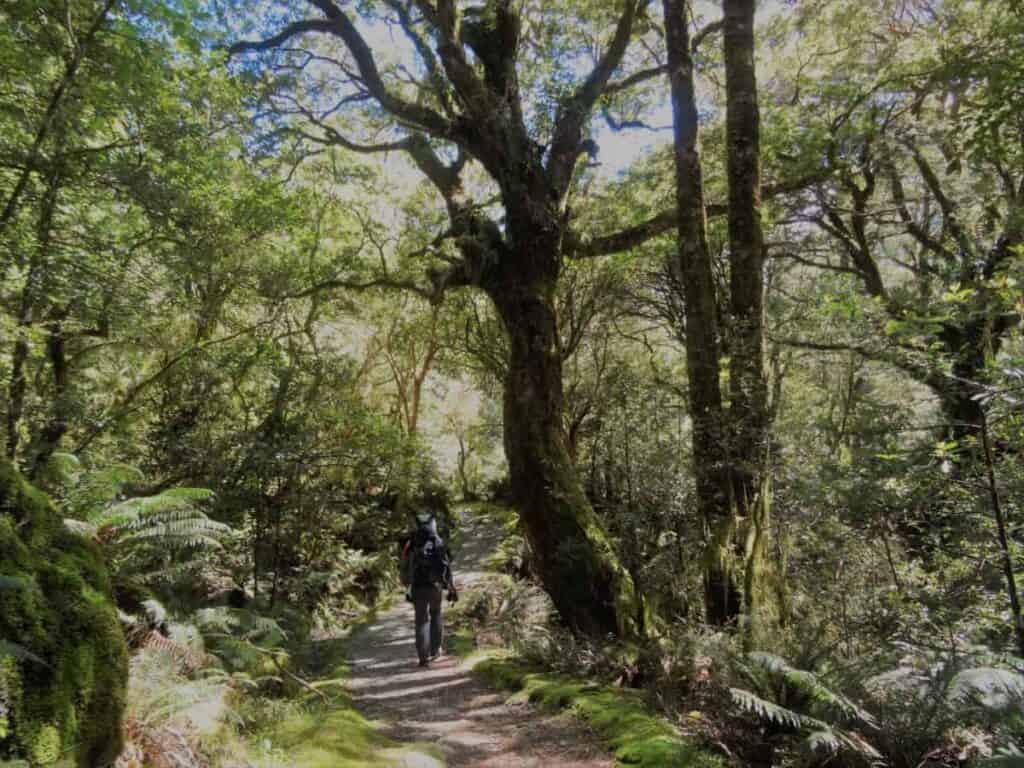
A good hiking pace can be anywhere from 2 MPH to 4 MPH, with 90%+ of hikers walking at 2-3 MPH. Hiking at 3 MPH is considered a very decent pace, but finding the pace right for you is based on your starting physical fitness, level of hiking experience, and ultimately, your unique goals.
There’s a lot to consider when it comes to getting the most from your hiking trips. Continue on and you’ll learn what typical hiking paces look like, what to think about when it comes to deciding your own, and how to improve your pace if you’re looking to push the limits.
By the way, as an Amazon Associate, I earn when buying qualified products through links on my site.
What’s Considered a Good Hiking Pace?
There’s really no one who can determine a good hiking pace for you, aside from yourself. Your fitness level, hiking experience and a whole lot more can affect the pace you can reach. Hikers of different experience levels can reach daily distances of anywhere from 8 to over 20 miles in a single day.
Ultimately, a good hiking pace is determined by whether or not you’re reaching your own goals. If your goal is to get through long hikes more quickly, then any level of improvement makes for a good pace. Generally speaking, aiming for 12-18 miles in a day will put you at a great average speed.
Those who want to reach the highest limits may aim for somewhere around 25 miles in a day. Meanwhile, others seek to use hiking as a way to help get in shape. If you want to learn more about hiking comfortably even if you’re out of shape, take a look at this section in our article on camping while fat and having fun.
If you ask me, any amount of hiking is good hiking, but it’s understandable that there are those who want to really push their limits when it comes to taking on the wilderness.
In summary:
- 2 MPH is a good speed
- 2.5 MPH is common for those who are generally fit and are going up and down hills
- 3 MPH is a superb pace
- 4 MPH is an extremely fast pace
What Affects The Speed Of A Hike?
Not all hikes are created equal. Each trail is different, each hiker is different and every time you head out onto the path, you’re likely to have a slightly different experience. As a result, there are a variety of different variables that can change your pace and the amount of ground you’re able to cover.
Below are just a few of those variables. Make sure to take them into account when you plan your hikes. That way, you can make sure they are working in your favor rather than against you.
Elevation
It’s one thing to hike on a perfectly flat space, but that’s not always the case when you’re out in nature. Hills, mountains and natural curves along the earth can result in changes to your hiking pace. Most of us slow down when we need to start moving uphill due to the extra effort, so make sure to consider this while looking at your pace.
Alternatively, moving downhill can result in your pace speeding up a bit. As a result, you’re likely to see some fluctuations in your pace that match up with these natural variations.
Weight Carried
Depending on how long you plan to be out hiking, the amount you bring with you may increase or decrease. Naturally, a simple day hike will require fewer goods than a multi-day backpacking adventure.
In either case, you’ll want to keep your pack as light as possible if you want to quicken your pace. If you’re finding that you aren’t keeping up the pace you want, then the weight of your pack might be something you want to take a look at, just in case it’s adding to the problem.
Amount Of Foliage
Most hiking locations will have a path that is clear enough for you to move through easily. However, that may not always be the case. Some of the trails that aren’t used as frequently may have more foliage growth, ensuring you need to be more careful as you move down the path.
Even trails that are more popular can be prone to things like upturned roots, rocks in the path and other kinds of obstacles. If you want to reach the quickest possible pace, then it’s wise to look for trails with limited obstacles in the way.
On one hiking trip, I remember that there were dozens of fallen trees over the path and those who maintain the trail hadn’t gotten to this trail for a while. This lengthened out the time of our hike considerably. Every fallen tree required some ingenuity to circumvent or some coordination to cross without falling over with our backpacks. Asking about the state of the trail from a ranger or someone who has hiked it recently will give you a better idea of this.
Perhaps one of the most common ways to slow down your trip are river crossings. If the rivers are shallow and can be “rock hopped” across, then that is still a reduction of your speed. If the rivers are wide and only passable by fording (walking in the water), then you will have to adjust your footwear (if you want to avoid walking with wet feet) at every river crossing which is going to affect your hiking time. I went barefoot through these river crossings, but even still my feet were in great shape at the end of the hike.
Understanding Of The Path
A trail you aren’t familiar with can certainly take longer to get through than one you’ve been on dozens of times. There is a heightened need to be more careful on a new path, and you may not know about all of the elevation changes that take place on it.
The more familiar you come to be with a particular trail, the easier it will be to move through it. As a result, you’ll see increases in your speed and a greater level of confidence as you hike the path.
What’s the Average Hiking Pace?
On average, hikers hike at about 2 MPH.
I asked a community of hikers, and 62% of hikers self-report they hike about 2 MPH on normal up-and-down terrain while about 32% of hikers self-report they hike about 3 MPH.

From personal experience, I’ve found that I (and those I travel with) hike anywhere from two to three miles each hour. That said, this speed can really be affected by the factors I discussed earlier.
For example, a steep path can bring your speed to around a single mile per hour. In spaces with heavy foliage, the same situation can occur. These aspects are worth keeping in mind when you’re selecting a place to hike.
This is more than how fast a person walks, this also includes breaks, and lunchtimes. This affects your hiking speed more than you might think.
What is the Average Hiking Distance Per Day?
Given that the typical speed is around 2-3 MPH, the distance that can be traveled can vary pretty greatly. If you opt to hike for six hours per day, you’ll be able to reach anywhere from 12 to 18 miles within a single day, assuming your pace is at least 2 MPH.
On the most recent backpacking trip we just went on, we managed to do a 2 MPH pace up the mountain, and a 3 MPH pace going down the mountain. It seems people go home at a quicker pace than they arrive, but that’s just my opinion on human psychology based on my experience.
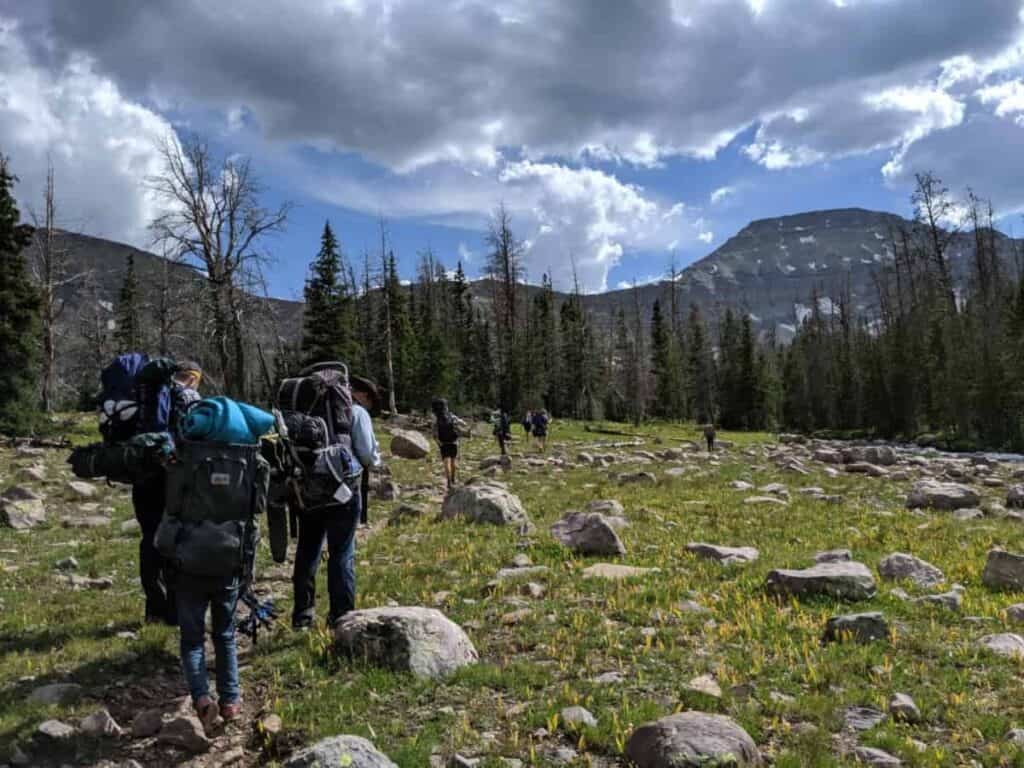
Not everyone may be able to maintain a pace of at least 2MPH all day long. There’s really no shame in that, as it is quite a long time to keep up that pace. There are many who may accomplish something like 8-10 miles per day.
If you’re someone who wants to push the limits, that may not seem like much of a distance to cover in a day but it is a fantastic starting point for newer hikers, or for those who just want any easygoing pace.
If you are a beginner, I would not plan on a distance greater than 8 miles. If it’s getting dark, it’s time to find a campsite off the trail a little ways and break camp. 4 hours is a pretty tiring hike, and if you’re not accustomed to it you’ll have hard time trying to do more.
Choosing the Right Hiking Pace for Me
When it comes to choosing your hiking pace, it’s best not to compare too much to others. Where you are starting may be completely different from the beginning pace of others. If you’re just getting started, you need to begin at a pace that works for you.
If you need to, start more slowly. If that means you can only get through 5 miles or less in a day, then that’s more than you would have covered staying at home. From that starting point, you can slowly improve your hiking speed over time.
Furthermore, make sure to consider your goals when you look at your hiking speed. If you’re happy knowing you’re making the effort to get out and hike at all, there’s nothing wrong with that. On the other end of the spectrum, you can also take the time and effort to learn how to reach those expert hiking levels!
How Can I Increase My Hiking Speed?
If you’re someone who wants to speed up your hikes, then there are a number of tips you can use to get your pace where you want it to be. Building up your strength and spending plenty of time walking is just the starting point.
As you work to improve your overall fitness, your hiking pace will benefit from the effort. Consider the following tips when you’re looking for ways to provide a boost to your typical hiking pace.
Practice
Much like any other sport or activity, hiking is a skill. You can’t expect to maintain the quickest hiking speeds right from the beginning. It’s going to take a lot of time and a whole lot of practice to reach the pace you want.
What’s worth keeping in mind is that the frequency of your practice is more important than the distance. What that means is that you’ll get a greater number of benefits from hiking shorter distances more often than trying to get through a long-distance hike every couple of months or so.
That also means that short walks around your neighborhood can also be useful in improving your hiking pace. Even if you only have a few minutes to spend practicing a day, it will still build up over time.
Me and my wife Diane trained for a hike through the Tongariro crossing in New Zealand, which was just over 12 miles, and was uphill over halfway of the journey. We went on hikes every weekend going a few miles every time. This turned out to be fantastic training for us, and we were able to go through the crossing without issues.
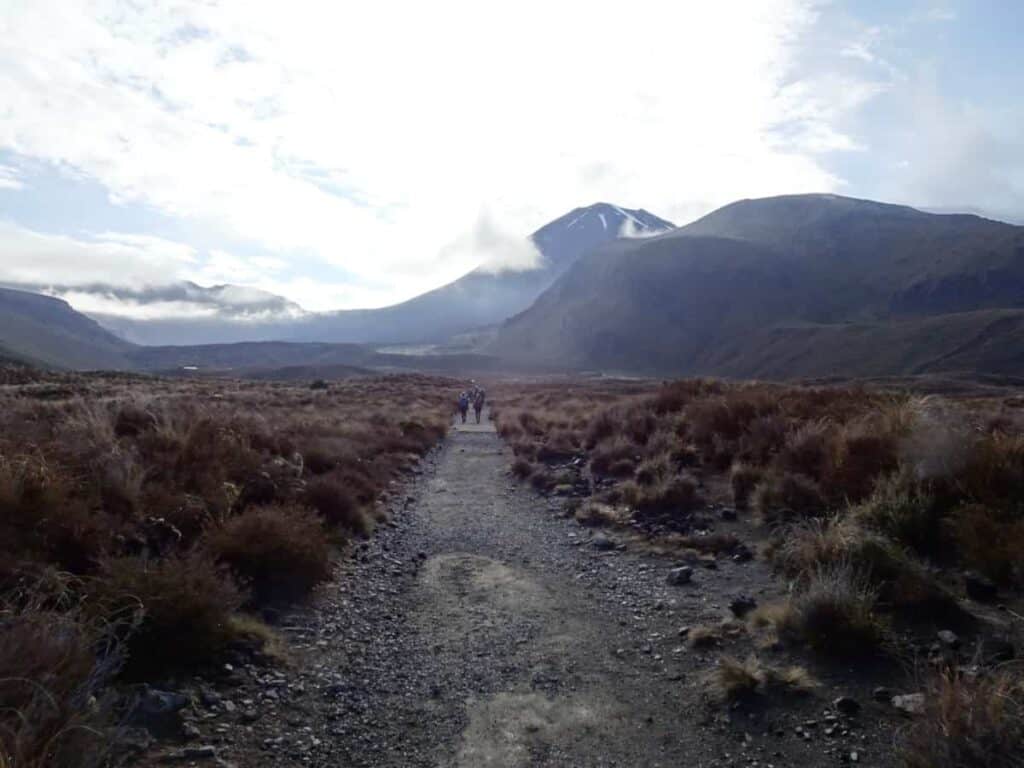
This was a revelation for us, since me and Diane went on a backpacking trip a year prior, and it was very hard for us. Hiking a few miles every week makes a big difference.
I know of a couple that trained by putting canned foods in their backpack and walking through their neighborhood. If you don’t have nature trails near your house, this will work, and will be effective in training your body.
Avoid Pushing Too Hard
Running yourself ragged on a hike isn’t going to create more results than moving at a brisk, but more comfortable pace. To improve your fitness, it is important to get your heart rate up. However, pushing too hard will increase your discomfort but not necessarily the benefits you receive from it.
On top of that, we all know the anecdotes about people who seek to get into better shape for the new year. They try to run five miles on day one, realize how painful it can be, and then give up entirely. It simply doesn’t work to force too much on yourself too soon, and it makes you less likely to want to give it a shot again.
Instead, take a look at where you are and try to improve in small amounts. If you’re timing yourself on a trail, then try to improve your time just a little bit each time. Even a second or two of improvement still counts. Otherwise, you can track your pace and work on keeping up a slightly higher pace each time.
Choosing Good Hiking Gear
Muscles and Joints:
By far, the most important piece of gear to help your hiking pace are trekking poles, also called hiking sticks. Trekking poles distribute the weight of your backpack to your arms as well as your legs, meaning you are using more of your body rather than just your legs. This improves your endurance (or at least it does for me). Not only that, but it saves your joints.
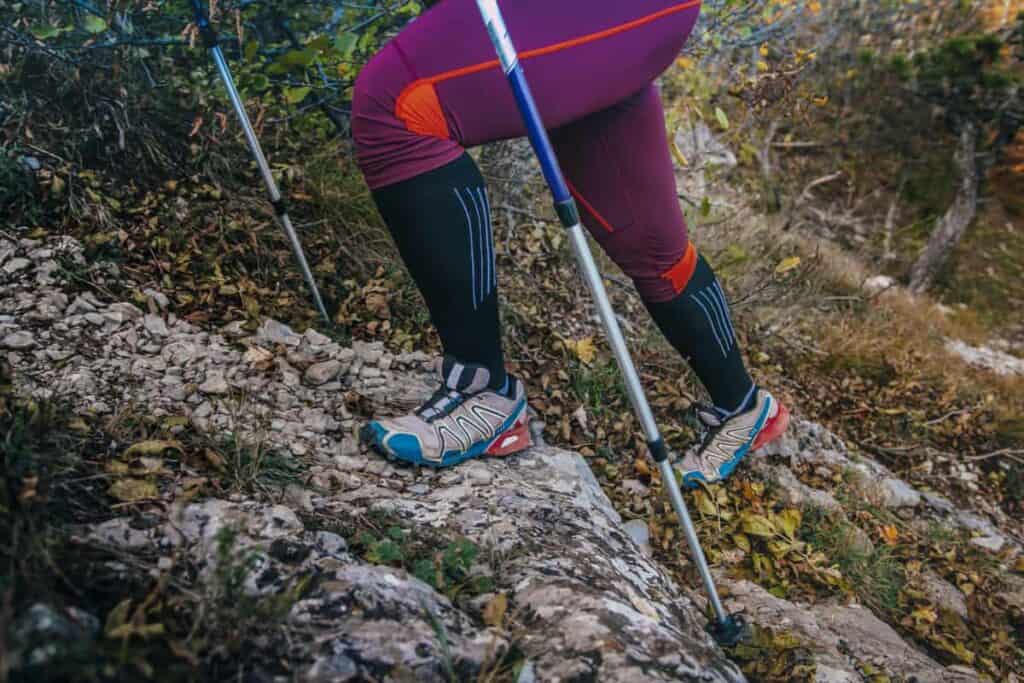
Perhaps you may not have thought of this, but if you experience knee pain or another one of your joints is giving you issues, you are going to have to hike much slower than you would have if you were healthy. Trekking poles make a huge difference on your joints and can forestall any pain you might experience.
I was hiking the Milford track when a woman on the hike was having tremendous pain while going downhill. Luckily she could borrow some trekking poles, and she was able to make it through safely.
Feet:
Feet are super important to your hiking pace. If your feet are hurting, then it will impact your whole experience since you are using those feet to get you where you want to go!
Quality shoes can make a huge difference. I highly recommend finding a step up above your regular tennis shoes and getting hiking shoes. I choose to use low-profile hiking shoes–the most important benefit for me is the strong sole which protect my feet from the millions of rocks and pebbles along the hike.
For those concerned about pace, there is a saying that 1 lb of shoes equals 5 lbs on your back. Some people opt to use lightweight shoes (Tevas are what are popular these days) that give some support and protection but are not near as hefty as a “hiking shoe”.
To me, it’s most important to have a shoe that protects my foot. You can test this by stepping on pebbles at home, if you can feel the distinct shape of the pebbles, your shoes might be a little thin. Remember that you’ll be feeling every one of these pebbles and rocks on your journey.
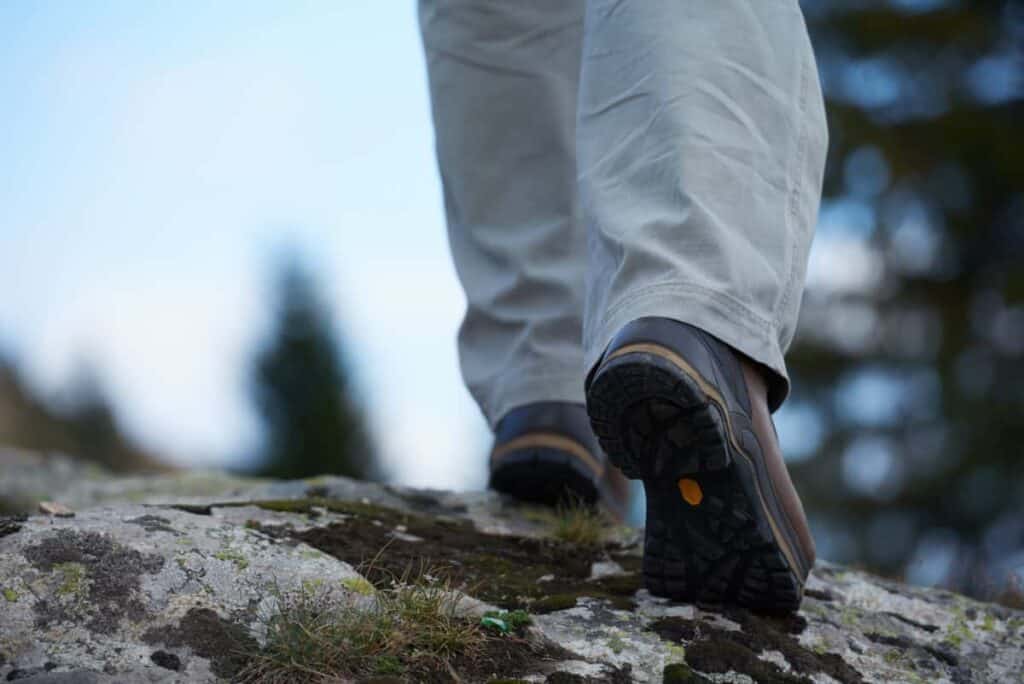
On my most recent backpacking trip, my brother swore by his neoprene socks. The newer neoprene socks are extremely thin and can be worn under another pair of socks, reducing friction against your feet. If you’re interested in learning more, check out the best neoprene socks to use for hiking in our article here.
Work On Your Overall Strength
Practicing your hiking and working on cardio are important aspects of improving your pace, but that’s not all you can do to pick up the speed. Additionally, you can do activities that improve the strength of your muscles. This helps them to endure the act of hiking more easily.
One of the most important areas to work on strengthening is your core. A strong core is the center for just about everything when it comes to physical fitness, whether you’re getting fit to swim faster, punch harder or hike better.
Take some time to work on strength training, and you’ll find that your hiking pace will improve alongside your physical strength.
Consider What You’re Carrying
I briefly touched on this earlier in the article, but I’d like to elaborate a little bit more because it’s a factor that can be very tough to figure out.
This concept is about more than just packing as light as possible. While you can do that to an extent, there are some items you absolutely need to have with you. For day hiking, this might include some water and a GPS at least.
However, if you’re backpacking for several days, you’re also going to need a lot more gear, such as a sleeping bag, food, first aid, water, GPS, your tent, to name just a few examples. It’s going to make your pack heavier, but those items are also non-negotiable. You can make lighter choices, such as carrying freeze-dried food, but there’s really only so much you can do!
This is another place where building your strength becomes important. You’re going to have to build up enough strength to handle the weight of your pack without it impacting your pace too much. As your body adapts, you’ll find that it becomes easier to carry more over time.
Baby Steps, Literally!
While it might seem confusing, taking steps that are smaller can actually result in a quicker overall pace. This may seem counter-intuitive.
When it comes to hiking, those larger steps can quickly leave you exhausted. As a result, you’re likely to slow down even more than you might otherwise. Instead, the smaller steps take up less of your energy and allow you to keep a more stable pace. This is especially true of going uphill.
In fact, some hikers will mindfully slow down their pace when going uphill. Instead of trying to go as quickly as possible, approach it from a marathon standpoint–preserve your energy, and walk mindfully, rather than short sprints of hiking requiring more rests.
Then, once the plane evens out, you can lengthen your stride to whatever is comfortable.
Slow and steady wins the race.
Growing Through Enjoyment
The most important aspect to remember is that hiking isn’t about punishing your body until it moves more quickly. First and foremost, hiking is about enjoying yourself and the natural world around you.
When you’re hiking, focus on having fun. If what you enjoy about it is the natural scenery, then take your time to soak it in. Spend time watching the animals, taking a look at unique flowers, and listening to the sounds of birds and other creatures around you.
The more time you spend hiking, the better you’ll be at it. Hiking is a wonderful way to get some exercise, clear your mind and provide your physical and mental health a huge boost. Get out there and enjoy it all you can!

